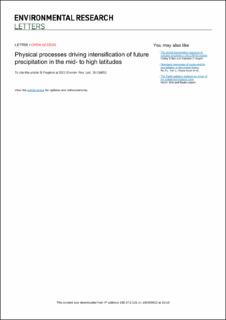| dc.contributor.author | Poujol, Basile | |
| dc.contributor.author | Mooney, Priscilla A. | |
| dc.contributor.author | Sobolowski, Stefan Pieter | |
| dc.date.accessioned | 2022-09-21T06:54:10Z | |
| dc.date.available | 2022-09-21T06:54:10Z | |
| dc.date.created | 2021-03-24T15:33:26Z | |
| dc.date.issued | 2021 | |
| dc.identifier.citation | Environmental Research Letters. 2021, 16 (3), . | en_US |
| dc.identifier.issn | 1748-9326 | |
| dc.identifier.uri | https://hdl.handle.net/11250/3020046 | |
| dc.description.abstract | Precipitation is changing as the climate warms, and downpours can become more intense due to the increased water holding capacity of the atmosphere. However, the exact nature of the precipitation response and its characteristics is still not well understood due to the complex nature of the physical processes underlying the formation of clouds and precipitation. In this study, present and future Norwegian climate is simulated at convection-permitting scales with a regional climate model. The future climate is a high emission scenario at the middle of the century. Hourly precipitation is separated into three categories (convective, stratiform, and orographically enhanced stratiform) using a physically-based algorithm. We investigate changes in the frequency, intensity and duration of precipitation events for each category, delivering a more nuanced insight into the precipitation response to a changing climate. Results show very strong seasonality, with significant intensification of autumn precipitation. An increase in convective precipitation frequency and intensity dominates the climate change signal regardless of season. While changes in winter and summer are well explained by thermodynamical theory, the precipitation response in autumn and spring deviates from the idealised thermodynamic response, partly owing to changes in cloud microphysics. These results show that changes in the precipitation distribution are affected in complex ways by the local climatology, terrain, seasonality and cloud processes. They illustrate the need for further and more detailed investigations about physical processes underlying projected precipitation changes and their seasonal and regional dependence. | en_US |
| dc.language.iso | eng | en_US |
| dc.rights | Navngivelse 4.0 Internasjonal | * |
| dc.rights.uri | http://creativecommons.org/licenses/by/4.0/deed.no | * |
| dc.title | Physical processes driving intensification of future precipitation in the mid- to high latitudes | en_US |
| dc.title.alternative | Physical processes driving intensification of future precipitation in the mid- to high latitudes | en_US |
| dc.type | Peer reviewed | en_US |
| dc.type | Journal article | en_US |
| dc.rights.holder | © 2021 The Authors | en_US |
| dc.description.version | publishedVersion | en_US |
| cristin.ispublished | true | |
| cristin.fulltext | original | |
| cristin.qualitycode | 2 | |
| dc.identifier.doi | 10.1088/1748-9326/abdd5b | |
| dc.identifier.cristin | 1900744 | |
| dc.source.journal | Environmental Research Letters | en_US |
| dc.source.volume | 16 | en_US |
| dc.source.issue | 3 | en_US |
| dc.source.pagenumber | 15 | en_US |
| dc.relation.project | Sigma2: NN9486K | en_US |
| dc.relation.project | Sigma2: NS9599K | en_US |
| dc.relation.project | Sigma2: NN9280K | en_US |
| dc.relation.project | Norges forskningsråd: 268243 | en_US |

